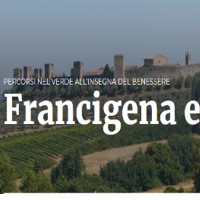
dal 1996 in continua innovazione tecnologica!
Sfrutta tecnologie avanzate per avere un sito web ottimizzato al 100%

A walk in nature, among the treasures of art and history: it looks like the old Via Francigena in Tuscany, the path taken by Sigeric, Archbishop of Canterbury, to Rome.
So began a real pilgrimage, in Tuscany, is entered at the current pace of Cisa.In past, the path is also used for other purposes, not only religious.
The Franks and carolingians, for example, they used to travel "slow" to interact with other communities. For this, the road reaches the town of walls, the powerful Lucca.
From there, he heads to Altopascio, crosses the Arno and runs through the Val d'Elsa, until reaching Siena.
Following the Cassia, the Via Francigena crosses the valleys of Arbia and Orcia towards Rome. The path runs along the main population centers, linking sacred sites of the Christian world. The way is now an important cultural route fueled by the emotion of limestone tracks left through the centuries, through pristine landscapes dotted with artistic treasures, to get in touch with the traditions of the places.
The Via Francigena offers a way for beauty and ability to summon is a paradigm of new way to travel slowly, making the route on foot, on horseback, by bicycle or by car-an inner journey, a journey of the spirit, religious or lay that is, that enriches the history and personal experience.
In Tuscany, the Via Francigena is closely related to other routes in the faith.
Think of the path of Francis, in the Tiber Valley, retracing the steps of the Saint before arriving at the sanctuary La Verna; or to variants of Roman pilgrimage routes, of the Via Clodia and of Via Pisana. From Lunigiana to Lucca, instead, we find the Via del Volto Santo, a journey of devotion in front of the Crucifix of Lucca Cathedral.
